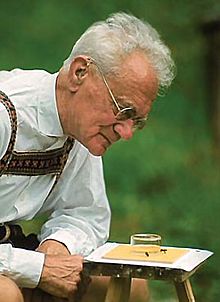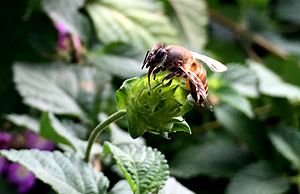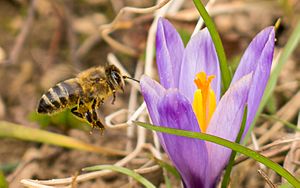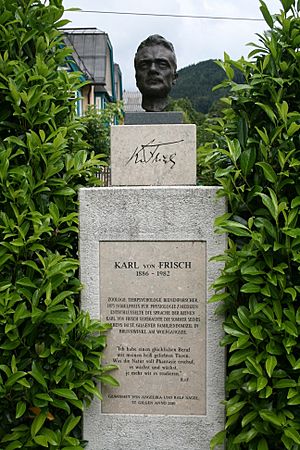Karl von Frisch facts for kids
Quick facts for kids
Karl von Frisch
|
|
|---|---|

In traditional dress, with his honey bees
|
|
| Born | 20 November 1886 |
| Died | 12 June 1982 (aged 95) |
| Nationality | Austria |
| Known for | Bees |
| Awards |
|
| Scientific career | |
| Fields | Ethology |
| Signature | |
 |
|
Karl Ritter von Frisch (20 November 1886 – 12 June 1982) was an Austrian ethologist who received the Nobel Prize in Physiology or Medicine in 1973, along with Nikolaas Tinbergen and Konrad Lorenz.
His work centered on investigations of the sensory perceptions of the honey bee and he was one of the first to translate the meaning of the waggle dance. His theory, described in his 1927 book Aus dem Leben der Bienen (translated into English as The Dancing Bees), was disputed by other scientists and greeted with skepticism at the time. Only much later was it shown to be an accurate theoretical analysis.
Contents
Early life
Karl von Frisch was the son of the surgeon and urologist Anton von Frisch (1849-1917), by his marriage to Marie Exner. Karl was the youngest of four sons, all of whom became university professors.
Karl studied in Vienna under Hans Leo Przibram and in Munich under Richard von Hertwig, initially in the field of medicine, but later turned to the natural sciences. He received his doctorate in 1910 and in the same year started work as an assistant in the zoology department of the University of Munich.
Career
In 1912 he became a lecturer in zoology and comparative anatomy there; and in 1919 was promoted to a professorship. His research on honeybees was continued by his student Ingeborg Beling. In 1921 he went to Rostock University as a professor of zoology and director of an institute. In 1923 he accepted the offer of a chair at Breslau University, returning in 1925 to Munich University, where he became the head of the institute of zoology.
Von Frisch attracted negative attention from the Nazi regime, among other things for employing Jewish assistants, including many women, and for practicing "Jewish science". Eventually Frisch was forced into retirement, but the decision was reversed because of his research on nosema infections in bees.
The institute of zoology was destroyed in the Second World War, and in 1946 Frisch went to work at the University of Graz, remaining there until 1950, when he returned to the reopened Munich institute. He retired in 1958 but continued his research.
Personal life
Karl von Frisch married Margarete, née Mohr, who died in 1964. Their son, Otto von Frisch, was director of the Brunswick natural history museum between 1977 and 1995.
Research
Frisch studied aspects of animal behaviour, including animal navigation, in the Carniolan honey bee (Apis mellifera carnica), a subspecies of the European honey bee.
Bee perception
Frisch discovered that bees can distinguish various blossoming plants by their scent. Surprisingly, their sensitivity to a "sweet" taste is only slightly stronger than in humans. Frisch was the first to demonstrate (in 1914) that honey bees had color vision.
Frisch's investigation of a bee's powers of orientation were significant. He discovered that bees can recognize the desired compass direction in three different ways: by the sun, by the polarization pattern of the blue sky, and by the earth's magnetic field, whereby the sun is used as the main compass, with the alternatives reserved for the conditions arising under cloudy skies or within a dark beehive.
Bees have an internal clock with three different timekeeping mechanisms. If a bee knows the direction to a feeding place found during a morning excursion, it can also find the same location, as well as the precise time at which this source provides food, in the afternoon, based on the position of the sun.
Dances as language
Knowledge about feeding places can be relayed from bee to bee. The means of communication is a special dance of which there are two forms:
Round dance
The "round dance" provides the information that there is a feeding place in the vicinity of the beehive at a distance between 50 and 100 meters, without the particular direction being given. By means of close contact among the bees it also supplies information about the type of food (blossom scent).
Waggle dance

The "waggle dance" is used to relay information about more distant food sources. In order to do this, the dancing bee moves forward a certain distance on the vertically hanging honeycomb in the hive, then traces a half circle to return to her starting point, whereupon the dance begins again. On the straight stretch, the bee "waggles" with her posterior. The direction of the straight stretch contains the information about the direction of the food source, the angle between the straight stretch and the vertical being precisely the angle which the direction of flight has to the position of the sun.
The distance to the food source is relayed by the time taken to traverse the straight stretch, one second indicating a distance of approximately one kilometer. The other bees take in the information by keeping in close contact with the dancing bee and reconstructing its movements. They also receive information via their sense of smell about what is to be found at the food source (type of food, pollen, propolis, water) as well as its specific characteristics. The orientation functions so well that the bees can find a food source with the help of the waggle dance even if there are hindrances they must detour around like an intervening mountain.
As to a sense of hearing, Frisch could not identify this perceptive faculty, but it was assumed that vibrations could be sensed and used for communication during the waggle dance. Confirmation was later provided by Dr. Jürgen Tautz, a bee researcher at Würzburg University's Biocenter.
Other work
Frisch's honey bee work included the study of the pheromones that are emitted by the queen bee and her daughters, which maintain the hive's very complex social order. Outside the hive, the pheromones cause the male bees, or drones, to become attracted to a queen and mate with her. Inside the hive, the drones are not affected by the odor.
Honors and decorations
- Lieben Prize 1921
- Pour le Mérite for Arts and Sciences 1952
- Foreign Honorary Member of the American Academy of Arts and Sciences 1952
- Elected a Foreign Member of the Royal Society (ForMemRS) in 1954
- Honorary ring of Vienna 1956
- Kalinga Prize for the Popularization of Science 1958
- Bavarian Order of Merit 1959
- Foreign Member of the Royal Netherlands Academy of Arts and Sciences 1959
- Austrian Medal for Science and Art 1960
- Balzan Prize for Biology "For having consecrated his entire life to experimenting on thousands of bees, thus discovering a true language of gestures for communication and opening new insights into the knowledge of insect behaviour" (motivation of the Balzan General Prize Committee) 1962
- Nobel Prize for Physiology or Medicine, with Konrad Lorenz and Nikolaas Tinbergen for his achievements in comparative behavioral physiology and pioneering work in communication between insects 1973
- Grand Merit Cross with Star and Sash of the Federal Republic of Germany (Großes Verdienstkreuz mit Stern und Schulterband) 1974
- Bavarian Maximilian Order for Science and Art 1981
- In his honor, the Karl Ritter von Frisch Medal of the German Zoological Society, is awarded every two years to scientists whose work is distinguished by extraordinary zoological achievements which represent an integration of insights from several different biological disciplines. It is Germany's most important science prize in zoology and includes prize money of 10,000 euros.
- Member of the German Academy of Sciences Leopoldina - National Academy of Sciences
- Honorary doctorates from a number of universities, honorary membership of numerous academies and scientific societies
Images for kids
-
Carniolan honey bee on a goldenrod flower head
See also
 In Spanish: Karl von Frisch para niños
In Spanish: Karl von Frisch para niños






